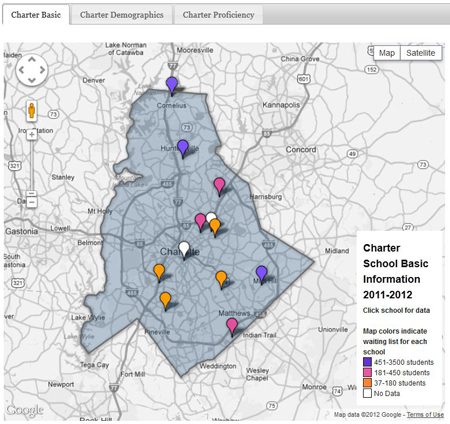Mecklenburg charter schools: Maps, data and more

In the 2011-12 school year, charter school students in Mecklenburg numbered 8,281, or 5.68 percent of the 137,497 students enrolled in Charlotte-Mecklenburg Schools.*
Local nonprofit MeckEd has organized information on local charter schools in a way that will help make it easier to understand more about each school and the results each is achieving. Bill Anderson, MeckEd’s executive director, explained, “MeckEd believes it is critical to provide accurate and objective information about all charter schools in Mecklenburg County.” MeckEd plans to provide this information – including academic performance, student demographics and per-pupil expenditures – annually. The summary of charter schools in Mecklenburg County that MeckEd compiled is available at: http://www.mecked.org/index.php/get-engaged/resources/local-charter-schools/
 Using data supplied by MeckEd, which is a data partner with the UNC Charlotte Urban Institute, institute researchers developed interactive maps that allow for exploration of the county’s charter schools. To see the interactive maps, scroll to the bottom of this article or click on the map at right.
Using data supplied by MeckEd, which is a data partner with the UNC Charlotte Urban Institute, institute researchers developed interactive maps that allow for exploration of the county’s charter schools. To see the interactive maps, scroll to the bottom of this article or click on the map at right.
Charter schools are public schools but have more flexibility to operate than other public schools. The hope is that this increased freedom will produce innovation and creativity that will benefit students. Last year, the N.C. General Assembly eliminated a 100-school maximum for charter schools in North Carolina. There are now 107 charter schools operating in the state, and that number could increase substantially in 2013-14.
Charters can be organized by national organizations or by groups from within local communities. Some have been created by for-profit groups. The goal of a particular charter may be to provide programs designed for a specific local area or subgroup of students.
The data MeckEd compiled reveal many differences in Mecklenburg’s charter schools. The schools range from new (Corvian Community School) to 15 years old (Community Charter). They vary widely in student demographics and proficiency scores. Proficiency is measured with different tests, depending on the grade level, so a comparison across all schools is not simple.
Comparing racial demographics among all the schools in the county is more straightforward. The graph below shows the racial breakdown at each charter.

* provides transportation. **does not provide lunch on any day or did not respond to lunch question. Source: MeckEd.
Notes: Racial data were supplied by schools, based on students’ self-reported race. For readability the groups “multi-racial,” “American Indian” and “other” are not shown above. Demographic data for Crossroads Charter is from 2008-09. To see more specific data for individual schools refer to the map below or to MeckEd’s site.
The schools fall into three categories when viewed by racial makeup: 80 percent or more white population (5 schools), 80 percent or more black population (4 schools) and schools with 40-60 percent white population (4 schools). Only at Metrolina Scholars Academy is any group other than black or white students more than 20 percent of the enrollment, with 39 percent Asian students. Mecklenburg County’s overall 2011 population was 60.7 percent white and 31.5 percent black. (Click here for more demographic information on Mecklenburg County.)
In North Carolina, while the total number of charter schools was limited to 100 until last year, charter schools have not been a static group. Since charter schools have been operating in the state 45 schools have either closed or were granted charters and never opened. According to the North Carolina Department of Public Instruction, since 1997, 30 charter schools have relinquished their charter, 11 have had their charters revoked and 4 schools did not have their charters renewed by the state. Note: Groups interested in applying to the board for a charter for the fall must submit a letter of Intent to the state charter office no later than noon Jan. 4, 2013.
|
About charter schools Charter schools are public schools that are primarily funded with public tax dollars. They have open enrollment across local school district boundaries. Click here for more information on N.C. charters. S.C. charter info is here. |
The N.C. State Board of Education closed Highland Charter in Gastonia last summer for purely academic reasons – the first time a state charter was closed based only on academics. (Note: This school should not be confused with Gaston County’s Highland School of Technology, a magnet school with strong academic performance). Kennedy Charter, in Mecklenburg County, has just been given a three-year extension of its charter (compared to the standard five-year period) in exchange for agreeing to specific academic standards.
A 2009 Stanford study of charter schools concluded that, “a decent fraction of charter schools, 17 percent, provide superior education opportunities for their students. Nearly half of the charter schools nationwide have results that are no different from the local public school options and over a third, 37 percent, deliver learning results that are significantly worse than their student would have realized had they remained in traditional public schools.” North Carolina was in the group of states in this report in which charter schools “had mixed results or was no different than the gains for traditional peers.”
Much debate since the study’s release has focused on the wide variation among charter schools and on the fact that many overall differences between charter and traditional public schools were quite small.
As the door has opened to creating more charter schools across the state, there will certainly be more interest in the successes and failures among these schools. Many questions are yet to be answered. Who will have access to these options? What is the return on investment for expending scarce resources on charter schools? What new levels of state supervision will a growing set of charter schools require? Is the competitive nature of charter schools vs. traditional public schools spurring innovation for both groups? Stay tuned.
Scroll below to see interactive maps.
Source: MeckEd. Note: data are self-reported by each school. See notes on maps at individual schools for more information.
The maps above show the locations of charter schools in Mecklenburg County and provide detailed information about each school. Select the tab to choose basic, demographic or proficiency data, and then click on individual schools to see data related to that school. Zoom or pan within the map to get a better idea of where the schools are. Data featured in the maps was supplied by MeckEd, which is a data partner with the UNC Charlotte Urban Institute. Click here to see summaries of each of the county’s charter schools from MeckEd.
*Download data summarizing N.C. county charter school populations here.